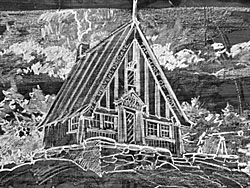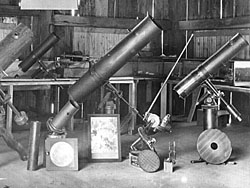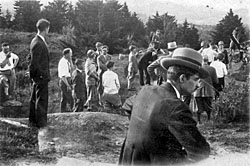

A Brief History of Stellafane
by Bert Willard
Springfield Telescope Makers Club Historian

High on a hilltop in southern Vermont, backed against a southern shield of tall spruce trees and facing north to Mount Ascutney is an astronomical observatory. It is the home of the Springfield Telescope Makers, the oldest group of amateurs in the country devoted to building and using astronomical telescopes and other scientific instruments. Stellafane, as the clubhouse is called, is a monument to Vermont inventiveness and a cornerstone of a hobby which sprang from fertile Yankee minds and spread throughout the country. The hobby became instrumental in creating the present public interest in astronomy and space exploration.
It all began on August 17, 1920 when fifteen men and one woman signed up to learn how to grind their own mirrors and make powerful reflecting telescopes. Most of the men were machinists, tool makers or pattern makers at the Jones and Lamson Machine Company in Springfield. The lone woman was a school teacher.
Their instructor, Russell W. Porter, was well prepared to guide them through the demanding though rewarding steps which required them to work to accuracies one-thousandth as large as they were used to in their daily precision machine work. Porter had spent years on the Maine coast teaching himself the art and science of building telescopes. This practically nonexistent hobby he took up to satisfy a drive which had slowly grown during his eleven years as an arctic explorer with Perry, Cook, Fiala and others. That drive was to learn more about astronomy.
After successfully completing their telescopes and using them for a while to explore the wonders of the universe the men decided to build a hilltop observatory and form an official club. On December 7, 1923 the first official meeting of the Springfield Telescope Makers, Inc. was held. Their clubhouse, Stellafane, was completed soon after.
From the very beginning the club attracted the interest and support of James Hartness, first as president of the Jones and Lamson Machine Company and then as Governor of Vermont (1921 - 1922). Hartness had earlier encouraged and financed Porter's telescope making struggles in Maine and had made his own amateur observatory, the world's first refracting turret telescope, still to be seen today at the Hartness House in Springfield.

display at a 1922 County Fair
Other luminaries sought refuge from daily drudgery among the simpler astronomical pursuits at Stellafane. Ralph E. Flanders, who later became a senator from Vermont, was a member from the beginning. Later Joseph B. Johnson joined the club. Even after serving as governor of the state he has never lost interest in the club activities to this day.
In 1925 an Editor of the "Scientific American" magazine, Albert G. Ingalls, heard about the small band of men building telescopes in Vermont and came up to investigate. He had been struggling with his own telescope and was eager to learn if there was any interest in building telescopes among his readers. During his visit to Stellafane he gathered enough information to run two articles with much of the material and illustrations contributed by Porter. The response was so great that Ingalls soon started a regular department devoted to amateur telescope making. Porter became a contributing editor. Throughout the 1920's the urge to build telescopes continues to spread across the United States and even to foreign shores. The move has helped to create a lasting foundation of public interest in observational astronomy. In recent years this had led to the growing attendance at planetariums and to the intense interest in space exploration.
In 1928 Porter was invited to join the staff of scientists and engineers being assembled to design the world's largest telescope, the 200-inch, to be erected at Palomar mountain. His abilities as artist, optical designer, mechanical designer and architect proved invaluable to the entire task which had never before been undertaken. Soon after Porter left Springfield to work on the 200- inch telescope a second Stellafane member, Oscar S. Marshall, joined him as a skilled machinist to work in intricate counterweights, drive gears and the like. The Springfield Telescope Makers is the only amateur organization to boast two of its members having worked on the world's largest optical telescope.
Under the leadership of Porter, the club members completed the construction of a large sixteen-inch reflecting telescope in 1930. Inspired by the success of Hartness' telescope to shelter the observer from the cold winter nights, Porter had borrowed the idea of the turret and modified it for a reflecting telescope. It stands today as the world's only reflecting turret telescope and is the envy of countless observers with its recently refurbished optics, rock solid mechanics, sheltered viewing room and, of course, the unpolluted black Vermont sky.

Since the 1920's, except during World War II, annual conventions have been held in the summer at Stellafane. These are weekend gatherings when amateurs come from all over the country to compare telescopes they have built and glean fresh ideas from guest speakers. Today the number of attendees reaches nearly a thousand and the web of influence reaches as far as California and Canada. It is an important addition to the American scene. Countless amateurs have been so overwhelmed with the hobby that they have taken up optics as their career. Even more have simply gained immensely from a satisfaction in sharing a rewarding hobby.
Stellafane continues to be an active hilltop observatory today. Its influence goes beyond Springfield or even Vermont. It provides inspiration, guidance and leadership among the amateur astronomy community as it did during the 1920's and 1930's. It is a landmark unique to the country and Vermont can be proud of heritage she harbors in the Green Mountain Observatory.
Back to the Early History Page